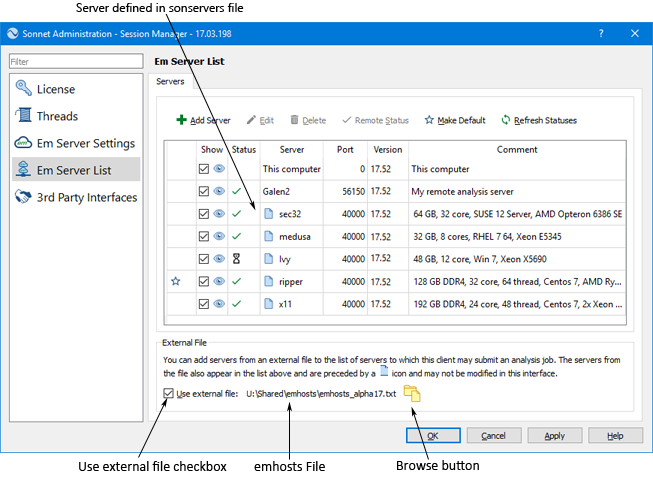If you are operating in a large environment where you have a lot of client machines, multiple analysis server machines or multiple versions of emserver on a single machine, you may find it useful to use the sonservers file as it can make managing several emserver machines, or multiple versions of emserver, easier.
The sonservers file allows you to define a remote server in an external file. This file is provided as part of your software installation. The default filename is <Sonnet Directory>/data/sonservers.txt. You may edit this file to add more remote servers; instructions on the format are included in this default file.
By default, this file is specified in the Em Server List page of the Sonnet Administration dialog box. You may use another sonservers file by specifying it in the Em Server List page. To specify a sonservers file, do the following:
The Sonnet Administration window appears on your display.
The appearance of the dialog box is updated with the Em Server List page.
Clicking on this checkbox loads the listed sonservers file. Any remote servers which have been defined appear in the server list. If a server has been defined in the sonservers file, a page icon ![]() appears next to it in the list of servers. Note that you may not edit the properties of a server from the sonservers file using the controls in this dialog box; you must directly edit the sonservers file. The default file initially contains no entries.
appears next to it in the list of servers. Note that you may not edit the properties of a server from the sonservers file using the controls in this dialog box; you must directly edit the sonservers file. The default file initially contains no entries.

Each line of the sonservers file lists a machine name, port number, and optionally comments. The comments can be helpful to users as you can include the amount of installed memory and other information about the machine. For example, the server sec32 in the illustration above has 64 Gigabytes of RAM and 32 cores.
This opens a browse window that allows you to select the desired sonservers file.
Managing several emserver machines is easier if the sonservers files are kept on a network drive in a central directory to which everyone has access. This way the administrator can generate the file and allow users to access it in order to configure their client machine. A separate sonservers file can be maintained for each version of Sonnet installed on the analysis server. Using a naming convention can help the user easily identify the applicable sonservers file.